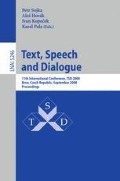Abstract
The method proposed by Diana McCarthy et al. [1] obtains the predominant sense for an ambiguous word based on a weighted list of terms related to the ambiguous word. This list of terms is obtained using the distributional similarity method proposed by Lin [2] to obtain a thesaurus. In that method, every occurrence of the ambiguous word uses the same thesaurus, regardless of the context where it occurs. Every different word to be disambiguated uses the same thesaurus. In this paper we explore a different method that accounts for the context of a word when determining the most frequent sense of an ambiguous word. In our method the list of distributed similar words is built based on the syntactic context of the ambiguous word. We attain a precision of 69.86%, which is 7% higher than the supervised baseline of using the MFS of 90% SemCor against the remaining 10% of SemCor.
Work done under partial support of Mexican Government (CONACyT, SNI), IPN (PIFI, SIP). The authors wish to thank Rada Mihalcea for her useful comments and discussion.
Access this chapter
Tax calculation will be finalised at checkout
Purchases are for personal use only
Preview
Unable to display preview. Download preview PDF.
References
McCarthy, D., et al.: Finding predominant senses in untagged text. In: Proceedings of the 42nd Annual Meeting of the Association for Computational Linguistics, Barcelona, Spain (2004)
Lin, D.: Automatic retrieval and clustering of similar words. In: Proceedings of COLING-ACL 1998, Montreal, Canada (1998)
Gelbukh, A.: Using measures of semantic relatedness for word sense disambiguation. In: Patwardhan, S., Banerjee, S., Pedersen, T. (eds.) Proceedings of the Fourth International Conference on Intelligent Text Processing and Computational Linguistics, Mexico City (2003)
Lin, D.: Dependency-based Evaluation of MINIPAR. In: Workshop on the Evaluation of Parsing Systems, Granada, Spain (1998)
Hays, D.: Dependency theory: a formalism and some observations. Language 40, 511–525 (1964)
Mel’čuk, I.A.: Dependency syntax; theory and practice. State University of New York Press, Albany (1987)
Pedersen, T., Patwardhan, S., Michelizzi, J.: WordNet:Similarity – Measuring the Relatedness of Concepts. In: Proceedings of the Nineteenth National Conference on Artificial Intelligence (AAAI-2004), San Jose, CA, pp. 1024–1025 (2004)
Miller, G.: Introduction to WordNet: An On-line Lexical Database. Princeton Univesity (1993)
Miller, G.: WordNet: an On-Line Lexical Database. International Journal of Lexicography (1990)
Resnik, P.: Using information content to evaluate semantic similarity in a taxonomy. In: Proceedings of the 14th International Joint Conference on Artificial Intelligence, Montreal, pp. 448–453 (1995)
Jiang, J., Conrath, D.: Semantic similarity based on corpus statistics and lexical taxonomy. In: International Conference on Research in Computational Linguistics, Taiwan (1997)
Fellbaum, C.: Combining local context and WordNet similarity for word sense identification. In: Leacock, C., Chodorow, M. (eds.) WordNet: An electronic lexical database, pp. 265–283 (1998)
Wilks, Y., Stevenson, M.: The Grammar of Sense: Is word-sense tagging much more than part-of-speech tagging, Sheffield Department of Computer Science (1996)
Sahlgren, M.: The Word-Space Model Using distributional analysis to represent syntagmatic and paradigmatic relations between words in high-dimensional vector spaces. Ph.D. dissertation, Department of Linguistics, Stockholm University (2006)
Kaplan, A.: An experimental study of ambiguity and context. Mechanical Translation 2, 39–46 (1955)
Author information
Authors and Affiliations
Editor information
Rights and permissions
Copyright information
© 2008 Springer-Verlag Berlin Heidelberg
About this paper
Cite this paper
Tejada-Cárcamo, J., Calvo, H., Gelbukh, A. (2008). Improving Unsupervised WSD with a Dynamic Thesaurus. In: Sojka, P., Horák, A., Kopeček, I., Pala, K. (eds) Text, Speech and Dialogue. TSD 2008. Lecture Notes in Computer Science(), vol 5246. Springer, Berlin, Heidelberg. https://doi.org/10.1007/978-3-540-87391-4_27
Download citation
DOI: https://doi.org/10.1007/978-3-540-87391-4_27
Publisher Name: Springer, Berlin, Heidelberg
Print ISBN: 978-3-540-87390-7
Online ISBN: 978-3-540-87391-4
eBook Packages: Computer ScienceComputer Science (R0)

